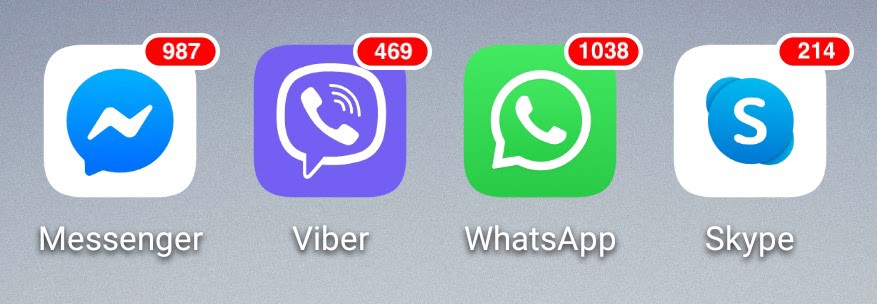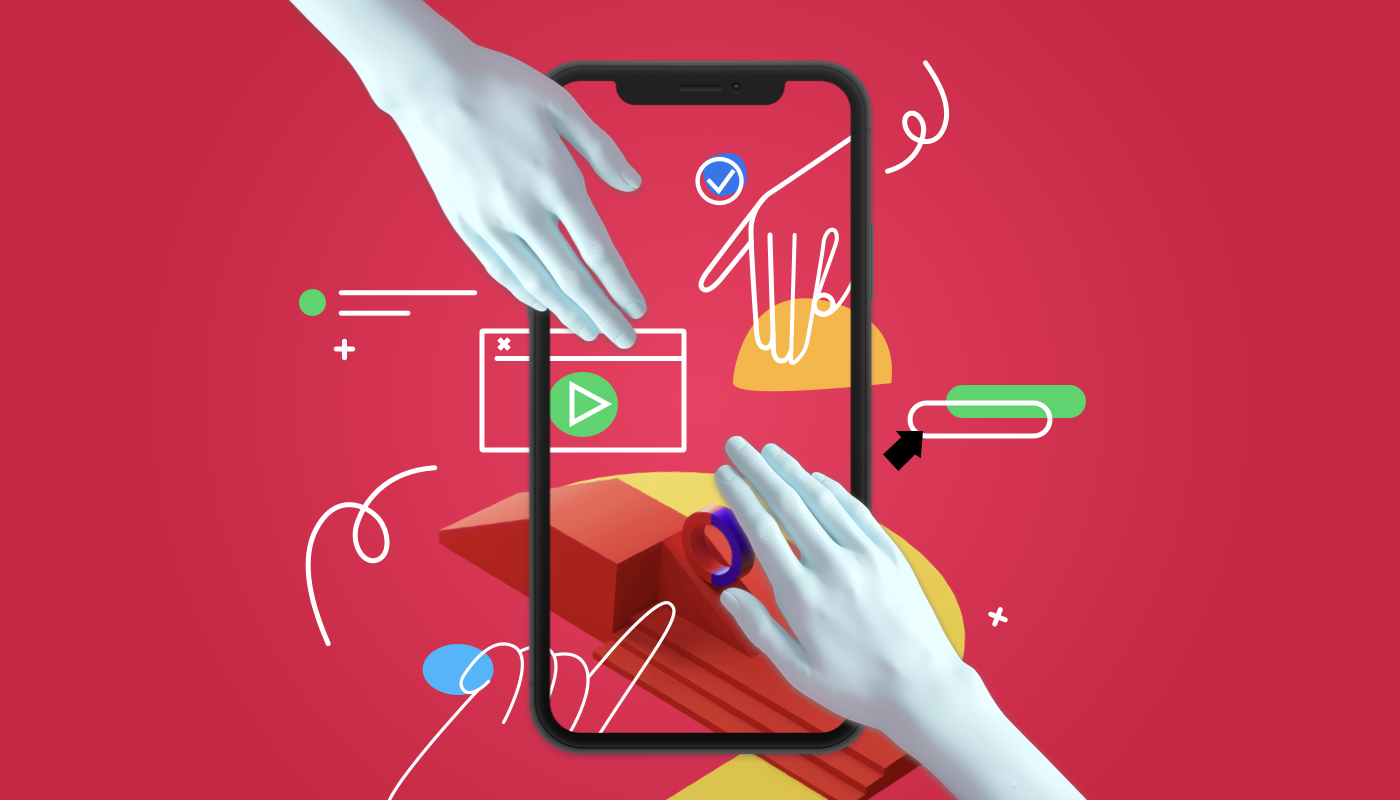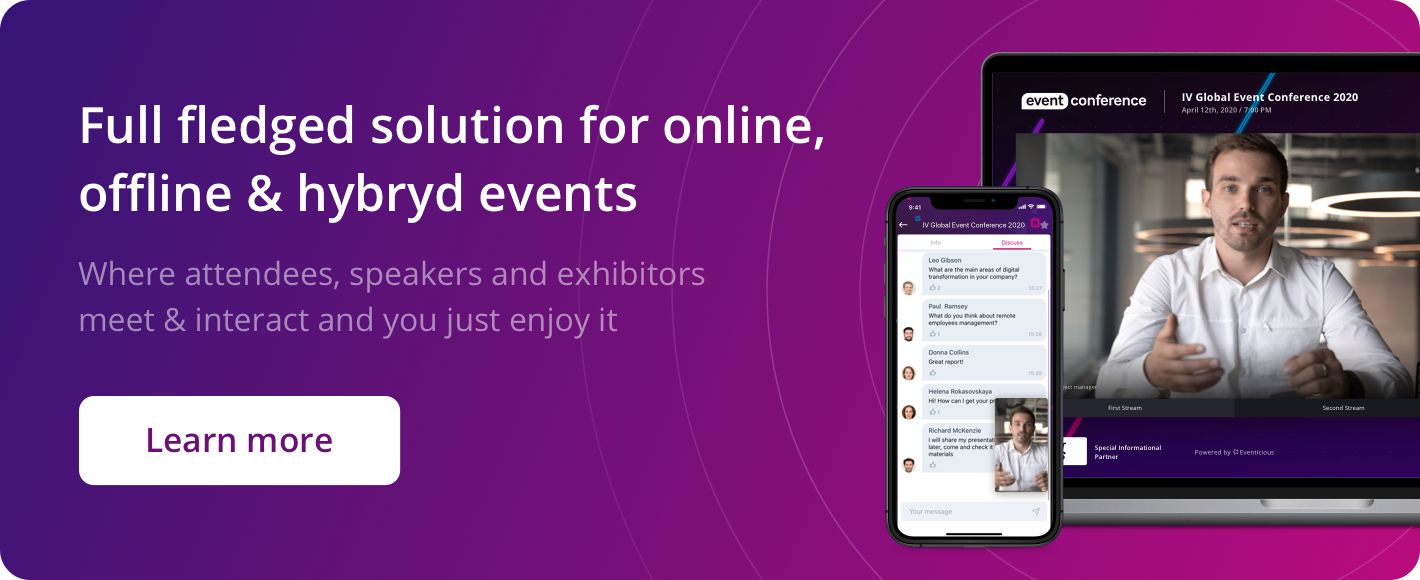76% of attendees come to events for networking, according to IAEE. Event organizers master a lot of different ideas intended to help attendees find useful contacts at events. Now that events are migrating into the virtual world, the challenge is to preserve their value as a networking platform, but in a new format.
Industry experts have named several networking tools that can be used at virtual events: chat boxes in live streaming videos, group chats in messengers, groups in social networks, and official mobile event apps.
When deciding which tool to select, we usually consider the following factors:
1) Convenient access
A networking platform must be easily accessible, be convenient and easy to use to most, or preferably to all attendees.
2) Informative value
For effective networking, the most important thing is to be able to quickly find information about potential business partners: who the attendees are, their core business and possible shared interests.
3) Privacy
At offline events attendees can reveal their personal information as they see fit and necessary. Not everyone likes to discuss business matters when they are not at work. In the ideal case, a professional community platform should help with finding useful contacts without crossing the line between work and personal life.
4) Post-event interaction
It would be a shame to lose all those connections when the event is over. Networking environment should remain accessible to participants even after the event and serve as a foundation of the community.

Now let’s take a look at the tools that are available for virtual events, considering the above factors.
1. Chat boxes in live streaming videos and webinars (YouTube, Zoom, Whereby, etc.)
The advantage of this option is the here-and-now factor: participants can share their thoughts as the broadcast goes on, can ask speaker questions or request more information about a certain topic. But this seems to be the only advantage.
As soon as the broadcast is over, discussion disappears. Then, finding any shared links or a company name will be quite a challenge.
Most likely, you’ll have to look somewhere else. Or, if nothing else has worked, you will have to wait until the recorded video has been uploaded and then look through the chat messages. But you won’t be able to continue the same discussion.
Just by reading the comments, it is practically impossible to figure out who is who in the chat.

As an option, the speaker can ask chat participants to introduce themselves in a few words. But if they decide to continue communicating in private, they will have to do so somewhere else; over the messenger or any other social network platform.
To sum it up: live stream chats are not exactly the right platform for contacting professionals or networking. They should be used only if no other options are available (and they usually are).
2. A messenger chat (WhatsApp, Viber, Facebook or Linkedin messengers)
Messenger chats are a good platform to discuss urgent questions or to share news or advice with those on the same wavelength. Unlike live stream chats, they have a chat history: discussions can still go on even if the event was held a year ago. This happens quite often.
Nowadays, messaging apps are used by almost everybody, and they are increasingly becoming the communication channel by default. Another advantage of messaging apps is their privacy. Participants do not need to be concerned about their private information being revealed. And, at the same time, that’s where their main disadvantage is, from the networking point of view.
It is certainly good to know a person’s first and last name, but if we are talking about searching for business partners, it would also be helpful to know their line of work and interests.
Chat moderators traditionally solve this problem by doing a roll call, but finding someone in this pile of information is not a simple task.
In many cases, chats turn into a dumping ground: one topic jumps to another, useful information gets lost in a second, and the questions won’t even be noticed in eight out of ten cases.

And on top of that, you are struggling to stay focused: just as you were about to ask an important question, you saw a notification from yet another — this time, parent — chat…
To conclude: messenger chats are convenient, but, on their own, they are not of much help when it comes to organizing effective networking. For that, we need an experienced community manager or moderator who will help participants find each other.
3. A group in a social network (Facebook, Linkedin)
The main advantage of such groups is that you can find out right away what everybody does for a living, what their interests are, what’s going on in their life, and their background. All you need to do is open their profile.
But this is also their main disadvantage: the information that many people share on social networks may be too personal. Some people post their vacation photos and do not share anything work related, others use different social networks for personal and professional stuff. So there’s always a risk that your potential business partner will not join the group because they are not ready to reveal all that personal information.

However, the good part of using groups in social networks as a networking platform is that they can become a good foundation for building a viable community. It is important to start the interaction at first, and then the community will run on its own.
The main thing is to bring together people with shared views and interests and then make sure to periodically post relevant content, ask questions and promote discussions.
Another option is to set up a social feed. That way, participants will generate content themselves. Moderator’s role becomes more important: rules must be implemented and enforced.
There’s one more weak point on social network groups: people spend limited time there. You can try making all attendees stay in the group chat for the duration of the event, but you need to understand that your event will have to fight for attendees’ attention with other content from that social network: photos and stories posted by their friends, news feed, etc. And winning this fight is not easy.
4. Official mobile event app
Anevent app is designed to serve as a “select few” club, and this is its huge advantage. From the start, it is clear to everyone that this is where all participants of the event will be gathered and that all communication will revolve around the event.
Unlike all other platforms, a mobile app can be branded to your event and customized to fit your goals and audience specifics. For example, you can make certain sections available only to attendees who purchased VIP access and offer them VIP networking.
Attendees can decide for themselves what personal information to share in their profile and what contacts to reveal. “I can help with” and “I am looking for” fields in attendee profiles can help start a dialog with a potential partner. As a rule, an event app makes it easy to find contacts that interest you by offering various filters, for example, in Eventicious app you can search by profile fields, and then send a personal message.

In an event app, you do not have to fight for attention with other content, like in social networks, and information does not pile up uncontrollably, like in messengers.
All communication is structured and organized, and the structure is determined by event organizers. You can have several separate chats for different topics or interests, for example, one for employee recruitment, another to discuss working from home, and yet another one for anything off-topic. Discussions that are related to presentations will be in an entirely different section, linked to the related presentations in the schedule. This way, all information remains organized and nothing gets lost.
Unlike messaging apps or social networks, an event app does not come preinstalled on attendees’ smartphones, they will have to perform a few additional steps to get into the networking space, and organizers will need to provide the instructions.
And now we have come to the main difference: an event app is not free. The cost can usually be covered through sponsor integrations, as we know from our experience, but this is an entirely different story that has nothing to do with networking.
So here is the bottom line: event apps are specifically designed to cater for attendee communication and networking. This solution will be perfect for larger events that are prepared to invest into a virtual networking platform.



